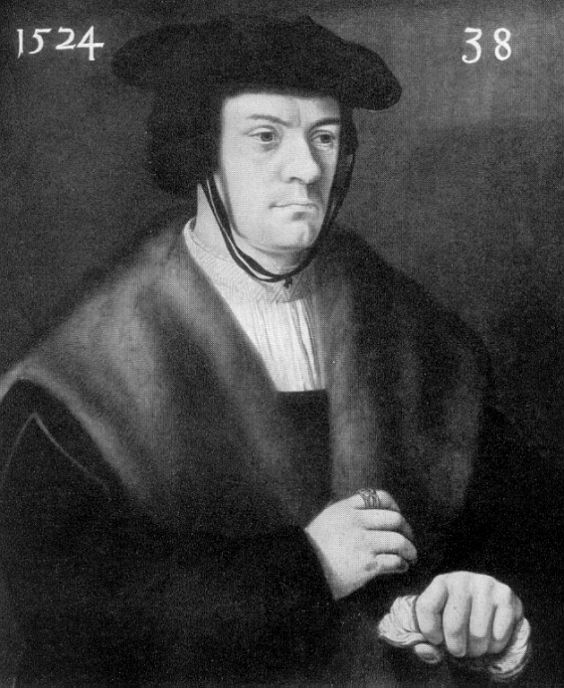
Agrippa von Nettesheim, born in Nettesheim near Cologne. Renaissance man, magician and often considered to be the historical Dr. Faust after his death in 18 February 1535
The Witch’s Advocate, Cornelius Agrippa was on a mission to bind man back to the First Principle, God. While not a witch himself, he was well-known for his involvement in occult matters and for defending those pursued by the Inquisition and accused of witchcraft or heresy.
In 1519 he was in Metz, Germany serving as an orator and advocatus of the town when an old woman was accused of witchcraft. Even though to him most women accused of witchcraft were “deluded old women”, he intervened and save the woman’s life. The old woman was from the village of Woippy where her mother was a witch.
Therefore, the other villagers accused the woman of being a witch by association. The woman was captured and brought before Dominican and Grand Inquisitor, Nicholas Savini, who sought to burn her at the stake. As her public defender, Agrippa eluded the possibility of witchcraft, thus shifting the focus from the accusation to the accuser.
He attacked Savini’s procedures asserting that they were irregular and even illegal for kidnapping the woman. But more importantly, he argued that the accusation based on the hereditary smear campaign was invalid, mostly because the woman’s mother who was also accused of being a witch was burnt at the stake before her and that the heresy of this accusation denies the power of her baptism.
To save the power of baptism and that of purging through fire, the Inquisition had no choice but to release the woman. Agrippa was successful in defending the witch, but his success resulted in his exile from the city of Metz. Regardless, he gracefully proved how you can beat them with their own weapons.
Just like many magicians of his time, Agrippa was a wanderer: he married three times, he never benefited of a long-term patronage, he never stayed in the same place for a long time and pursued many professions such as theologian, legal expert, soldier, and physician.
He was a German polymath that became one of the most renowned occult writers of all time. He studied the occult sciences, he was politically involved and dedicated himself to the problematic theological and legal questions that attracted accusations of heresy. While he was never gravely persecuted for his interest in the occult arts, he did raise controversy and was negatively cited by many.
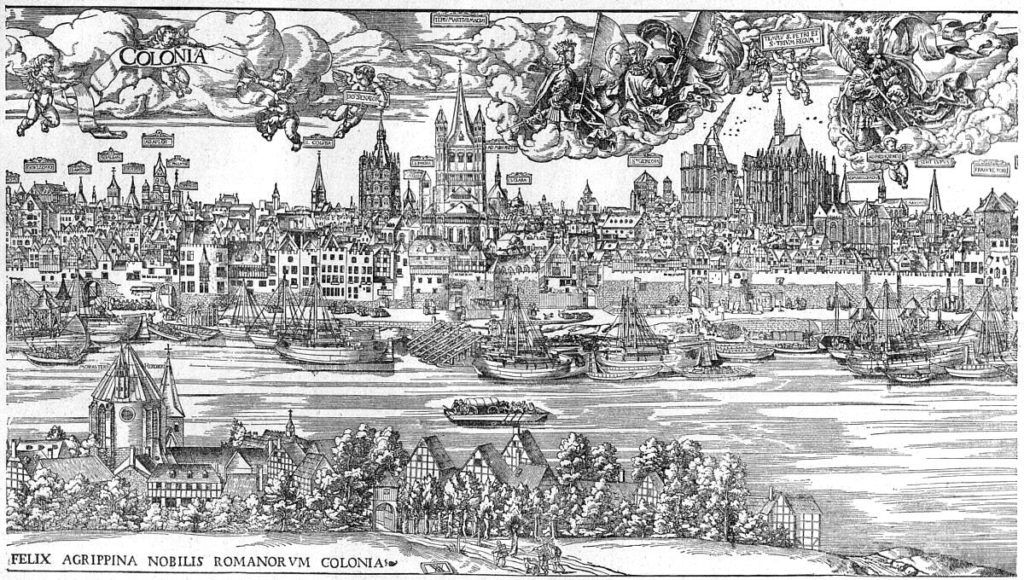
Köln – Cologne 1531, according to a woodcut by Anton Woensam / Anton of Worms
Years of Wandering
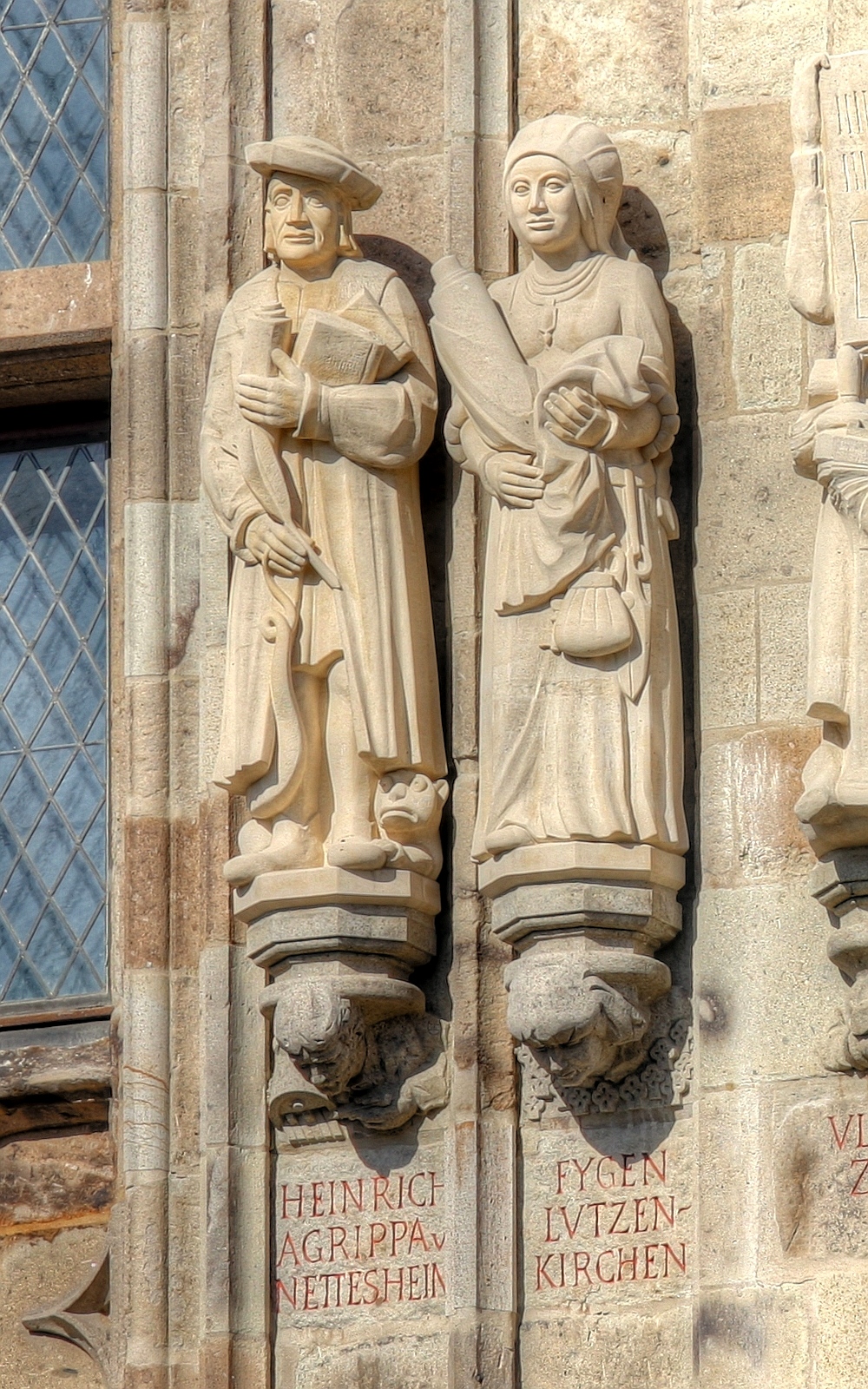
Statue of Agrippa of Nettesheim (left) among other personalities of the city’s history. Sculptor was Wolfgang Reuter, who added von Nettesheim in 1992. Image © Raimond Spekking / CC BY-SA 4.0 (via Wikimedia Commons)
Heinrich Cornelius Agrippa von Nettesheim was born on September 14th, 1486 in Nettesheim near Cologne, Germany. As a child, Agrippa wished to follow in his father’s footsteps who respected the family’s tradition of serving the royal House of Habsburg. But Cornelius Agrippa went on to be a scholar.
He graduated from the University of Cologne in 1502 with a self-proclaimed degree in medicine and a doubtful doctorate in Canon and Civil Law. He pursued his interest in natural philosophy at the school of Albertus Magnus in Cologne. During his youth, he established many relationships with humanists who shared his interest in the wisdom of Antiquity.
He traveled to France where he formed a secret initiatory circle otherwise known as a sodalitium which consisted of other personalities at the time, and at some point, after that, he even went on a mysterious military mission to Spain. In 1509 he was appointed to lecture on Christian Kabbalah at the University of Dole in Burgundy which he began with a prolusion in honor of the Margaret of Austria, the daughter of Emperor Maximilian, Princess of Austria and Burgundy.
This prolusion developed into a treatise in praise of womankind that he dedicated to Margaret and it was the precursor of his De nobilitate et praecellentia foeminei sexus declamatio (Declamation on the Nobility and Pre-Eminence of the Female Sex), which was published only in 1529. His lectures attracted substantial interest from members of the University and the Parlement, so he joined the college of theologians.
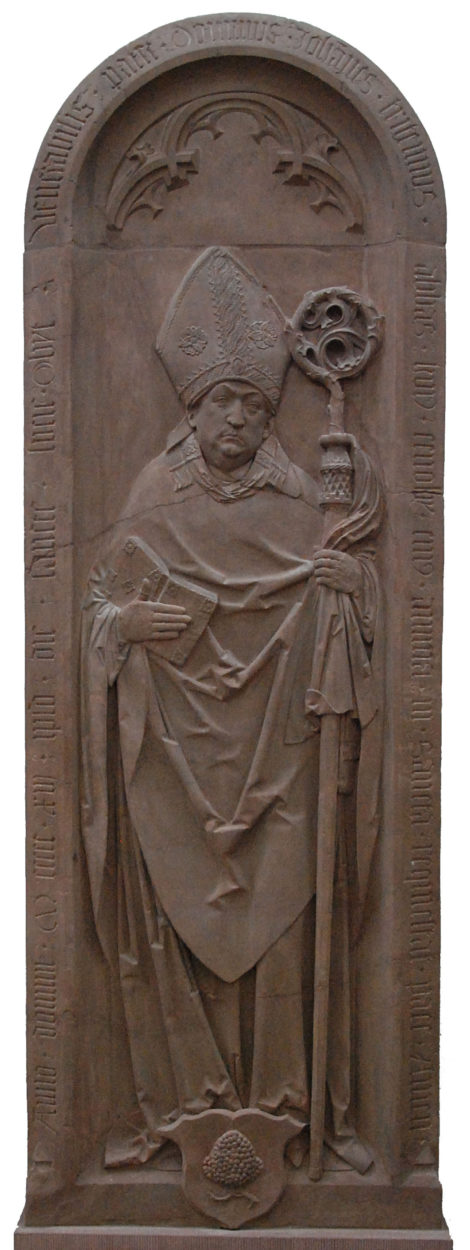
Benedictine abbot Johannes Trithemius (Born 1462, Johann Heidenberg, died 1516). Mentor to – inter alia – Agrippa and Paracelsus.
However, the Franciscan Jean Catilinet who was the provincial superior of Burgundy denounced Agrippa as a “Judaizing heretic”, which ended Agrippa’s teaching career. In the winter of 1509-1510, Agrippa returned to Germany and went to the monastery of Saint Jacob in Wurzburg, where he met the Abbot of Sponheim, Johannes Trithemius. Trithemius became Agrippa’s mentor and shared his interest in natural magic.
Their discussions helped Agrippa complete his compendium on magic that he had been working on for some time. This compendium, known as the first draft of De Occulta Philosophia was dedicated to his mentor, Trithemius, who received a manuscript sometime around 8 April 1510. Upon examining Agrippa’s work, Trithemius expressed the following:
“Your work, most renowned Agrippa, entitled Of Occult Philosophy, which you have sent by this bearer to me, has been examined. With how much pleasure I received it no mortal tongue can express nor the pen of any writer. I wondered at your more than vulgar learning—that you, being so young, should penetrate into such secrets as have been hid from most learned men; and not only clearly and truly but also properly and elegantly set them forth.”
The compendium circulated in manuscript form for quite some time, but Agrippa continued to develop it and 20 years later he finally completed the final version of De Occulta Philosophia as we know it today.
In 1510, Agrippa went on another mysterious military mission, this time to London, on the orders of Maximilian I. There he was introduced to the study of Saint Paul’s epistles, which lead him to write Commentariola (Little Commentaries) which seems to have been lost in time. While there, Agrippa also wrote Expostulatio super Expositione sua in librum De verbo mirifico cum Joanne Catilineti (Expostulation with Jean Catilinet over His Exposition of the Book On the Wonder-Working Word) in response to Catilineti’s accusations, which was the first work in a series of epic battles with his contemporary theologians.

Portrait of Agrippa by Boissard. 1645
Copyrighted work available under Creative Commons Attribution only license CC BY 4.0
In between 1511 and 1518, Agrippa continued to serve Maximilian I in Italy, where he also lectured Plato’s Symposium and on the Hermetic Pimander at the University of Pavia. He was forced to quit his lectures and leave Pavai when the Swiss and Imperial troops were defeated at Marignano. He attempted to obtain patronage at the court of Marquis de Monferrato, to whom he dedicated 2 of his works: De homine (On Humankind) and De triplici ratione cognoscendi Deum (On the Threefold Way of Knowing God).
While there, he frequented circles that enabled him to explore more Neoplatonic and Hermetic literature. In the following years (1518-1524) Agrippa became a city orator and advocatus in Metz, started practicing medicine in Geneva and became a city physician in Freiburg. During this time, he gained a reputation as an “occult philosopher”.
He wrote De originali peccato declamatio (Declamation on Original Sin) in 1518 (which was printed in 1529) that puzzled his circle at the time with his interpretation of Adam’s original sin. He also participated in the debate of St. Anne’s triple marriage and supported Jacques Lefèvre d’Étaples’ criticism of the tall tale that she had three husbands and three daughters. In his De Beatissimae Annae monogamia ac unico puerperio (On St. Anne’s Monogamy and Sole Childbirth, printed 1534), he responded to the accusations of heresy against him and Lefèvre.
During this time, he had also successfully defended the woman of Woippy who was accused of witchcraft, saving her life. These events especially earned him the respect of many scholars, but it also caught the attention of religious authorities at the time.
Agrippa moved to Lyon in the spring of 1524 as the physician of Louise of Savoy, the mother of Francis I. He wrote De sacramento matrimonii (On the Sacrament of Marriage, 1526) which he dedicated to Marguerite d’Alençon, the king’s sister. He benevolently referred to her as an “Erasmian spirit”, which she was offended by, thus failing to win her favor.
This also made his reputation worse in front of the religious authorities that identified Erasmian influence in his works and positive attitude towards marriage. His Dehortatio gentilis theologiae (Dissuasion from Pagan Theology) raised suspicions about his religious orthodoxy, his correspondence with the Duke of Bourbon (who betrayed the French Crown) questioned his political loyalties, his refusal to provide an astrological prognosis for François I, and his remarks about Louise’s superstition – all of this attracted hostility towards him.
He was denied pension and forbidden to leave France. Meanwhile, he wrote his De incertitudine et vanitate scientiarum which launched an attack on the moral and social assumptions of his time. When he was finally able to leave France, Agrippa accepted the position as an archivist and imperial historiographer at the court of Margaret of Austria in Antwerp. It is then that he was finally able to start printing and publishing his written work.
His published works have once again caught the attention of the religious authorities and the Louvain theologians who questioned Margaret of Austria herself for her association with Agrippa and they deemed his De vanitate as heretical. Agrippa was requested to reply to these accusations and so he responded by writing Apologia (Defense) and Querela (Complaint) in which he refuted criticism and accused his accusers of ignorance and bad faith.
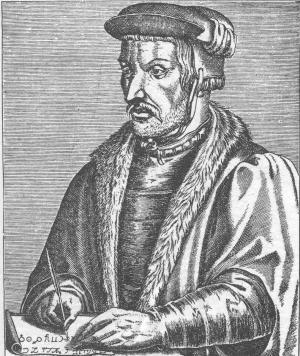
Agrippa von Nettesheim in his later years. His ability to win a case against the inquisition and his involvement into the “dark arts” earned him a questionable reputation and often he would be referred to as the historical Dr. Faust
This ended his career at the court. But Hermann von Wied, Archbishop of Cologne, who had an interest in the occult sciences, offered him protection and welcomed him into his home. He was finally able to complete his De Occulta Philosophia and with the intervention of Hermann he was able to print it, despite the Inquisition’s efforts to suspend it.
Very little is known about the last years of Agrippa’s life. According to his student, Johann Weyer (Wierus), Agrippa was in Bonn until 1535 when he returned to France and was promptly arrested on the orders of François I. Johann writes in his De praestigiis daemonum that Agrippa died in Grenoble in 1535. Augustin Calmet wrote that as Agrippa’s time of death neared, his dog jumped into the Rhone river, which lead many to believe it was a familiar or a demon.
According to some sources: “As early as 1525 and again as late as 1533 (two years before his death) Agrippa clearly and unequivocally rejected magic in its totality, from its sources in imagined antiquity to contemporary practice.” Many believe his repudiation of magic was sincere, but others suggest that it might’ve been misunderstood. He may have merely retracted his first draft of De Occulta Philosophia, but not his final draft.
Aggripa’s Heritage
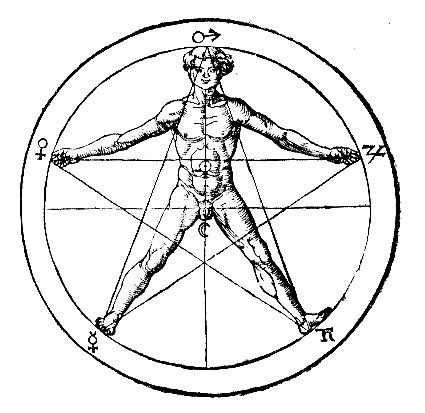
The Pentagram set into relation to man’s anatomy and the seven planets – Gravur after Agrippa von Nettesheim as discussed in Book two of De Occulta Philosophia
Cornelius Agrippa was undoubtedly the most influential writer of the Renaissance Esoterica. His magnum opus, De Occulta Philosophia – Three Books of Occult Philosophy, remains one of the leading texts of Western esoteric thought even 500 years later.
The famous fourth Book of Occult Philosophy – a grimoire on evocation – appeared only in 1559 – 24 years after Agrippa’s death and is of unclear origin. The “Magickal Elements” is typically attributed to Peter de Abano.
While many believe he recanted it, in fact, he had only admitted that his earlier work on magic was juvenile. But his mission to renew magic was at the center of his intellectual journey at all times. He believed that the reform of magic (magia reformata) would not only invest the magus with mastery over nature and the ability to attain astral and angelic virtues, but it would also enable his ascension to the First Principle, God.
“Seeing there is a Three-fold World—Elementary, Celestial and Intellectual—and every inferior is governed by its superior, and receiveth the influence of the virtues thereof, so that the very Original and Chief Worker of all doth by angels, the heavens, stars, elements, animals, plants, metals and stones convey from Himself the virtues of His Omnipotency upon us, for whose service He made and created all these things: Wise men conceive it no way irrational that it should be possible for us to ascend by the same degrees through each World, to the same very original World itself, the Maker of all things and First cause, from whence all things are and proceed; and also to enjoy not only these virtues, which are already in the more excellent kind of things but also besides these, to draw new virtues from above.”
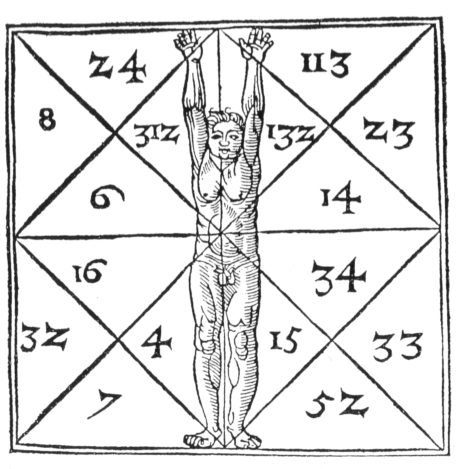
The proportions of the body of man and numerological relations after Agrippa von Nettesheim – Book Two of De Occulta Philosophia
De Occulta Philosophia attempts to recover “true magic” in the context of Hermetic theology and Neoplatonic metaphysics in order to offer mankind a full restoration of cognitive and practical abilities and the knowledge to work wonders.
His systematic exposition of the occult has an encyclopedic quality that showcases Renaissance magic and passes down knowledge of the occult virtues, the Divine Trinity, The Kabbalistic names of God and evil spirits, the order of the evil spirits, types of divination, numerology, planetary rulerships, the various states of natural things, astrological talismans, and even enchantments and sorceries.
Furthermore, each of the three books corresponds to the three realms: elementary, celestial, and intellectual. For Agrippa, all things have descended from God and through the same realms He’s descended in, it is possible to ascend back to God.
Through his De occulta Philosophia and De incertitudine, we see an emerging paradox of a comprehensive treatise on magic and a rebuttal of all products of human reason that coexist in his work. He had never retracted one or the other, so through this Agrippa shows us that the paradox is inherently natural.
This paradox challenges the readers and practitioners to be in two different realms of speculative concerns at the same time. This is why Agrippa’s heritage is both a cultural and a religious project. Furthermore, Agrippa had a very well thought writing strategy that used erratic juxtapositions and borrowed material to hide the true purpose of his work.
This dispersia intentio must be put together by the student (reader/practitioner) to find the message he intentionally concealed in a scattered exposition. This is typical of sapiential tradition and it was used by Renaissance scholars who were “forced to create spaces for themselves by merging learning with prophecy” (Celenza 2001: 128).
The concepts and quotations that Agrippa’s texts consisted of, where from both ancient and contemporary sources and he systematically removed them from their original context to give them a new revelatory structure. Perhaps this can also be seen as a model on how to de-construct and re-construct a magical system.
This systematic re-construction enabled Agrippa to find implications that the sources themselves often left unspoken. He was able this way to connect the implications in a single design. In the words of Couliano: It is a “systematic exposition of … Ficinian spiritual magic and Trithemian demonic magic (and) … treatise in practical magic”. Furthermore, Agrippa was able to introduce a political meaning in these texts that emphasize the civic function of philosophy.
Even though De Occulta Philosophia provides methods of using the four elements, astrology, Kabbalah, etc in medicine, alchemy, divination, and ritual magic, this work distinguishes itself from others at the time. What separates it from other grimoires at the time is that the three books are more scholarly than they are foreboding – and so they continue to provide a coherent system to those in the study of the occult arts and sciences.

The moondragon – one of the images of the moon sphere in Book Two of De Occulta Philosophia
De Occulta Philosophia and Modern Occultism (Thoughts by Nettle)
De occulta philosohpia has been named by translator Donald Tyson the “foundation Book of Western Occultism” (1992). For practitioners who consider themselves as part of a stream, which through history and time runs unbroken – sometimes visible at the surface , sometimes concealed in the depths – it may be debatable how unique or “new” Agrippa really is. What remains undebatable though, is that his opera is the first to systematically and comprehensively describe the pillars of western esoteric thought and that his undertaking of giving a complete overview at hand was unmatched for centuries until Crowley and Regardie broke the seals of silence by publishing the magickal system of the Golden Dawn, thus providing a large audience for the very first time with a workable and coherent system of applied western esoteric thought, while still being deeply rooted in the hermetic worldview described in De occulta philosophia. Likewise, Franz Bardon, the second occultist in the 20th century to provide a complete and coherent system of Western Occultism, does by no means replace Agrippa’s work, but develops it further and translates it into our contemporary understanding of the world.
Indeed, Agrippa’s writings are deeply influenced by the understanding of the world of his time and its specific body of knowledge. It is exactly this part, which makes De occulta philosophia sometimes hard to approach. Not necessarily because Agrippa never left the Christian paradigm and monasteries where important places of his life and work. No, Christianity during the Renaissance was surprisingly open – at times – as humanists such as Reuchlin or the omnipresent Neoplatonists in Italy began to revive classical philosophical texts, translated the corpus hermeticum or integrated the Kabbalah into Christian thought, making it such a part of Western esoterics, without which a large part of today’s western occultism would be plainly inconceivable. This era witnessed a new generation of scholars, ready to view nature as a book to be opened and discovered, while with one leg already storming the heavens with science, with the other leg still stuck in medieval superstitions and in their hands holding the torches of timeless wisdom. Agrippa is no exception, but a primary example. And it is this feature, when reading hermetic classics, which makes reception difficult: it may be a matter of taste, when Agrippa lengthily cites the classics – for example Virgil or Ovid, to prove his point, however, it soon will become obvious that he takes stories about mythological beasts such as the Phoenix at face value and accordingly uses it to illustrate timeless laws and principles of nature.
The reader furthermore learns, for example, that the suckling fish “doth so curb the violence of the winds, and appease the rage of the sea, that, let the tempests be never so imperious and raging, the sails also bearing a full gale, it doth notwithstanding by its mere touch stay the ships and makes them stand still, that by no means they can be moved”. This dubious fish is called witness several times during the first book, and has to testify for the elements, the laws of polarity and basic principles of sympathetic magick. In the German version by the way, it is by no means clear which fish he does mean by this illustrative name, while English readers are spared such dilemmas by translating it plainly with echeneis, which indeed is a choice more plausible than the catfish, even though the modern reader will know, that no known fish possesses such abilities.
And while aspects like this bring a lot of joy to curious readers, they do not necessarily build up trust, which naturally should pose some problems at some point. So, for example the fish or serpent “Myrus” – it is unclear if Agrippa is aware that he is talking about the Moray eel, which he featured already in other parts of the book – could be used to heal the inflammation of the eyes, if its eyes are bound to the forehead of the patient, and if they were taken in such a way that the “serpent is let go alive”. As the patient heals, so the fish Myrus will build new eyes itself. Another magickal recipe against ghosts, advices for Mule hair in the middle of a certain crystal bound to the left arm as the talisman of choice. And while we are amused today (I know I am) about these applications of symapethetic magick, we still hold the healing signatures attributed by Agrippa to many crystals or herbs in high regard: caring little for the fact that to most contemporary scholars and other muggles all of the aforementioned notions seem nonsensical.
Today we still use the laws and tables of of elementary and planetary analogies as systematically laid out in the second edition of De occulta philosophia. The seals and hours of the planets, the 28 moon stations, the genies and intelligences of the spheres, the four, respective five elements, even though Agrippa still used the Western term “spirit” or “Aether”, for what nowadays often is referred to as Akasha , and the 3 realms or plains, which after all are nothing but different degrees of density of the Akasha principle: mental, astral, physical. It is all there, not by coincidence only corresponding to the 3 parts of his opera.
Indeed, differences exist: Agrippa obviously understands the elements as real, physical building blocks of matter and our real world. Nowadays we take comfort as viewing them as principles, while leaving the elements of matter to Mendeleev and his colleagues. Nevertheless, maybe by slightly anticipating the latter, Agrippa for the first time introduced three orders of the four elements, increasing in complexity and decreasing in pureness to explain the large variety of substances in the real world, which obviously more often do not feature pure fire, water, air or earth (the typical bird or tree contains none of these in the pure form…). By doing so, he makes the first and very timid steps into the direction of modern science, even though to many of his contemporaries he may have seemed already storming fast into the heavens of a new paradigm.
From a hermetic point of view, it is interesting that Agrippa views the earth element as the most basic one, as it is the earth element which beholds all others. This approach is very inductive and makes sense from an alchemical point of view. However, it also makes sense from a practical point of view: after all, the typical cabalist will ascend the Tree of Life starting at Malkuth, and not at Kether, which in and by itself may exist only in a deductive world. Let’s remember here that every Sephirot contains all other Sephirah at any point on the Tree of Life. It is worthwhile to think about this for some time. Maybe this was also Bruno’s ontological remark on the matter.
This however, maybe an uneasy thought to spiritual currents, which seek enlightenment and salvation beyond the world, rather than in it.
Agrippa here, proves himself to be a progressive thinker – despite his nowadays seemingly obscure knowledge of nature – starting with the obvious. And as such, he actually was one of the first to find knowledge in the real world, rather than in the library and the sole repetition of the past.
Agrippa viewed science or in his own words “philosophy” as threefold: physics, mathematics and theology. Physics in his understanding was a comprehensive study of nature and may comprise such doctrines as the one of the four elements and modern fields such as biology. Mathematics is not the abstract theoretical science of today, but has as an important function the very practical task to observe, measure and describe the movement of celestial bodies. Theology finally teaches the mysteries, and the intelligences for the theurgist to meet. Again, these three disciplines correspond with the three realms: physical, astral and mental, to use modern hermetic language. Magick, however, is the forth, the ultimate science (philosophy) which has the former three at its base but brings them to their ultimate perfection.
Thus, the magician is the one, who by knowing the laws of cause and effects in the entire universe, is able to work his will be setting new creative causes in a top-down approach, starting on the mental level, and materializing it step by step, by using the right astral analogies to imprint the mental idea through the astral level into the appropriate physical correspondences. This deep understanding of the laws of cause and effect and the ability to create, not just to re-arrange already existing effects – is something we find in Bardon’s distinction between the magician and the “wizard” (German: “Zauberer”), who is limited to sympathetic magick and piggybacking on others’ efforts.
This complex system of correspondences at its very core is used in Western occultism until today, and few attempts except Crowley’s Liber 777 have been made to expand or even alter it. And while some parts may seem obsolete today, it should be clear that this seems so, because of a chain of progress which was spearheaded by Agrippa – not mimicked. It is the responsibility of each generation to – at least – translate the body of occult knowledge into the current worldview, or even to develop it further and to become a net contributor to progress. Currently, about 100 years after the revolution of the Golden Dawn, it still seems that most magickal texts still stand in Agrippa’s shadow. Sometimes, because this knowledge is so timeless, sometimes because men – and women – of Agrippa’s stature are born so rarely – even across centuries.

www.NettlesGarden.com – The Old Craft


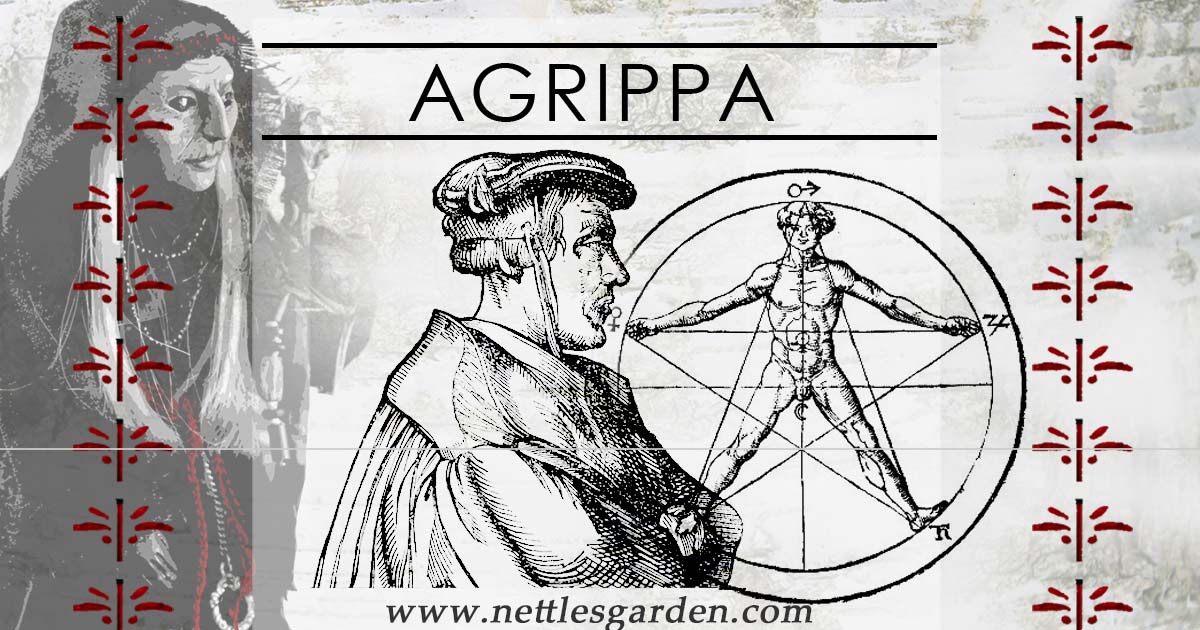


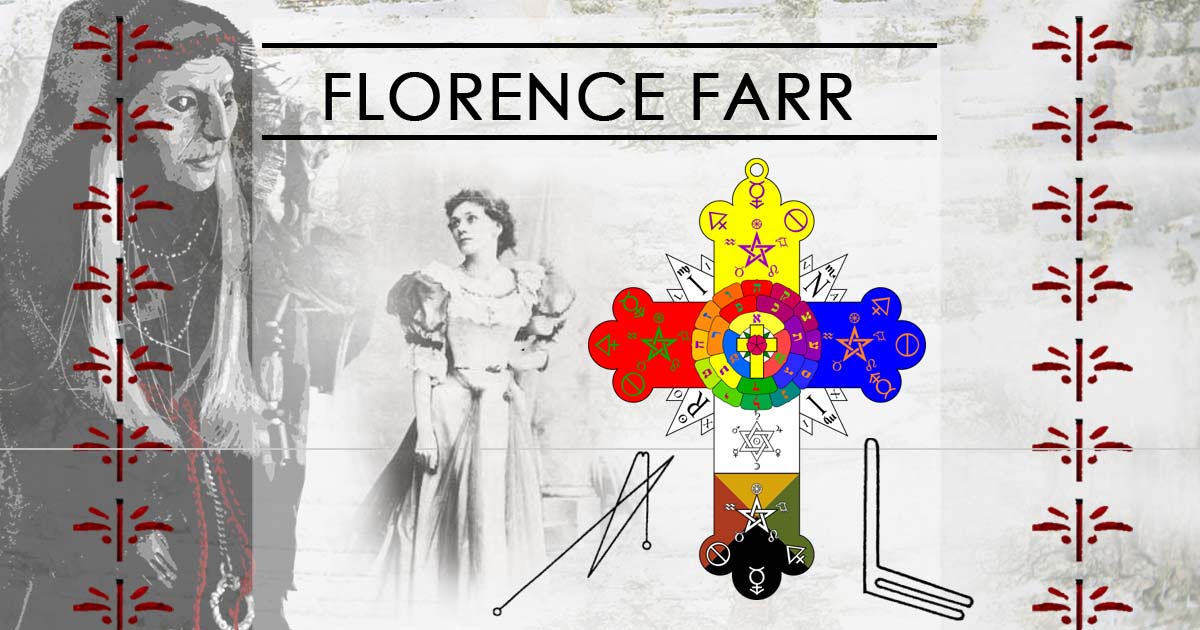
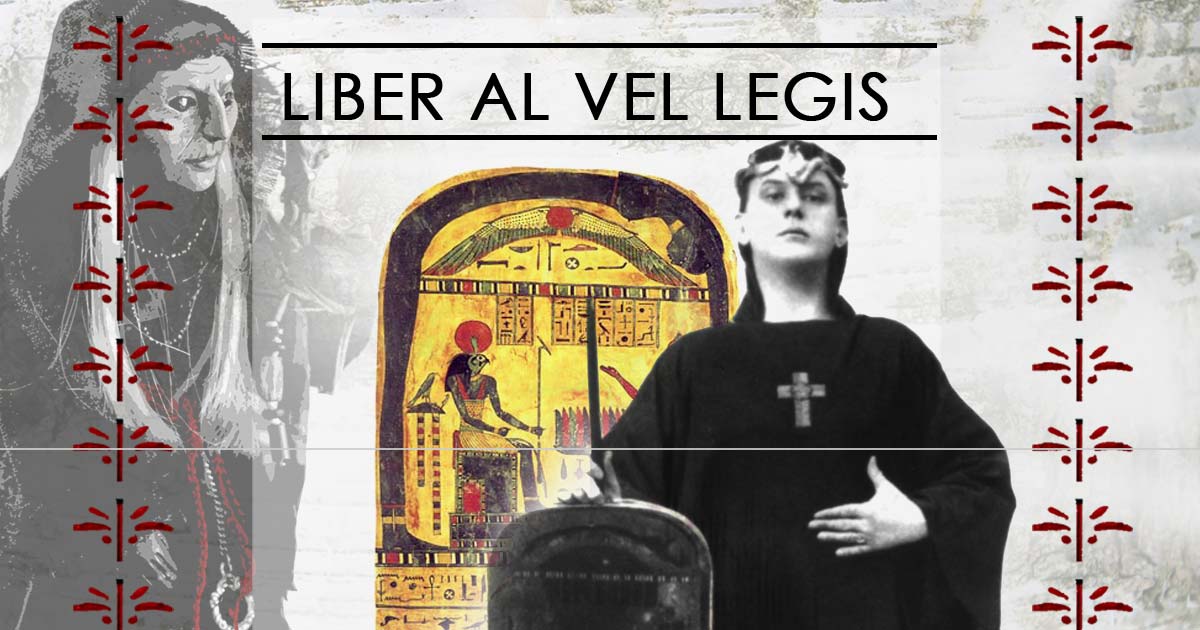
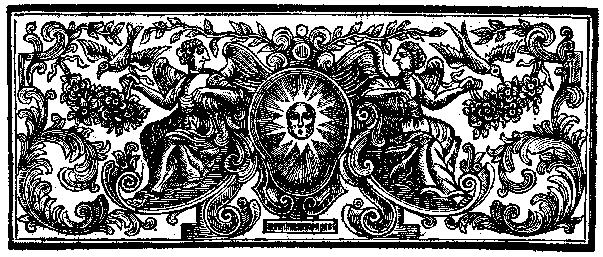
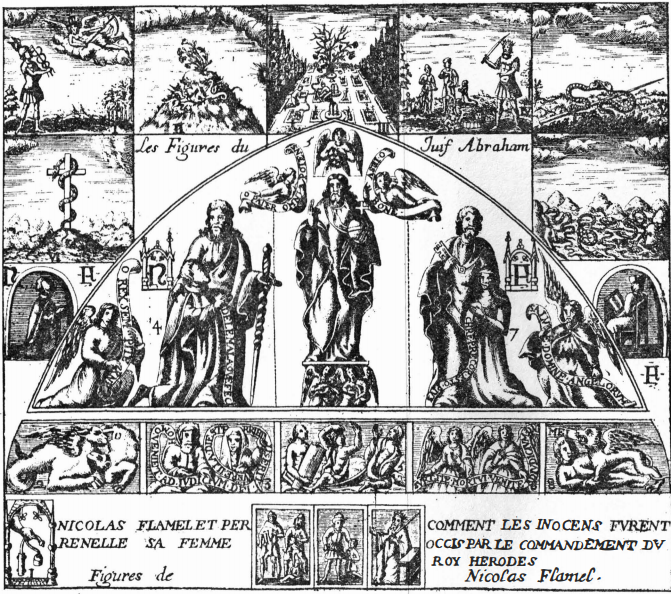
Rahne | February 20, 2018
|
Wow, I wasn’t aware that such intensive biography of Cornelius Agrippa was even available. Nice digging. Loving this series!
Alexander | February 21, 2018
|
Glad you like it 😀
There are some more nice Agrippa stories around, but next in line is an interview with a modern magician and a brother in Alchemy from France, who was born about 3 centuries ago
Radiana Piț | March 3, 2018
|
Thank you, Rahne! I’m glad to read you’re loving it and I hope you’re going to enjoy our newer articles just as much. 🙂